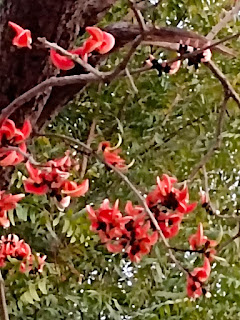Flame of the Forest (Kesudo/ Palash)
Months of February and March, travelling through the country side in the Indian Subcontinent, you see a spectacular change in the skyline. Suddenly, you see forest is on fire, and then, you realize that Palash is in full bloom. Butea Monosperma, known as Palash, Kesudo and sacred tree are very significant to Indian Mythology but also has a lot of value in Ayurveda. In our Mythology, Lord Krishna plays Holi with the Palash flowers. During Saraswati Puja on Vasant Panchami flowers of Palash are must. The indigenous knowledge derived through generations pins the remedial properties of Palash flowers to control various skin problems due to extreme heat in the Summers. Leaves of a Palash tree are traditionally associated with making of biodegradable cutlery known as "patrala". Roots of the tree has medicinal properties while the trunk of the tree is used as fire wood. Although, bright orange is the colour that is associated with Palash, you can find some variations of colour in white, yellow and purple. Keshudo, Palash, Flame of the forest or by whatever name that we call this flower it makes the Spring Season, the ambience, the feeling of it completes it into 'one whole'.
Gurudev Tagore gives a special treatment to Palash in his penned songs on Bashanto
O re grihabasi khol dar - We are putting up the translation of it from 'Geetbitan.com'
Open your door, the home-dweller, everything's on the swing.The land, water, the forest floor all swing. Open, step out of your door. Loads of crimson blossoms of ASHOK and PALASH, all in smiles, Crimson euphoria spread with clouds across the morning sky, Young leaves catch crimson vibration. Open, step out of your door. - by Anjan Ganguly









Thank you for sharing,love them whenever i see them in Bloom....always wanted to know their name.I did not know in hindi they are called Palaash.
ReplyDeleteIn sanskrut
DeleteIt is called
Kimchuk.
Yes KESHUDO FOR HOLI THESE FLOWERS ARE USED TO MAKE COLOUR
ReplyDelete